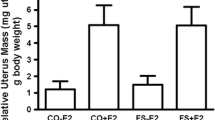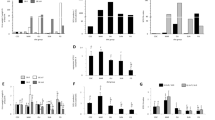Abstract
Purpose
The conversion rate of α-linolenic acid (ALA) into docosahexaenoic acid (DHA) is determined by dietary and non-dietary factors. Higher capacity of DHA synthesis has been evidenced in females, indicating that sex factors influence the conversion pathway. To evaluate the extent to which sexual dimorphism of DHA synthesis is subordinated to nutritional handling, we measured the ω3 ∆4-desaturation index in male and female rats receiving adequate or inadequate amounts of ALA. The ω3 ∆4-desaturation index was drawn from the DHA to docosapentaenoic acid (ω3DPA) ratio in liver phospholipids.
Methods
Male and female rats born to ω3-deficient dams were fed a supplemented diet supplying low, inadequate, intermediate, or adequate ALA (5, 20, 100, or 300 mg ALA/100 g diet, respectively). Control rats from both gender received the adequate diet from fetal life.
Results
Compared with control, low ALA feeding induced the ω3 ∆4-desaturation index to increase by 38 and 70% in the phosphatidylethanolamine fraction of males and females, respectively, and by 67% in phosphatidylcholine in females only. Supplementations with increased doses of ALA progressively smoothed this gender effect. Moreover, the analysis of our data from a previous study shows that ovariectomy decreased, whereas estradiol treatment increased the ω3 index to values comparable with those of diet-matched males and intact females, respectively.
Conclusion
Females are more prone than males to increase their index of ω3 ∆4-desaturation, especially in response to low supplies in ALA. Estradiol supports the ω3 index, suggesting that this hormone plays a role in the effect of gender on DHA synthesis.




Similar content being viewed by others
References
Brenner RR (2003) Hormonal modulation of Δ6 and Δ5 desaturases: case of diabetes. Prostaglandins Leukot Essent Fat Acids 68:151–162
Bokor S, Dumont J, Spinneker A, Gonzalez-Gross M, Nova E, Widhalm K, Moschonis G, Stehle P, Amouyel P, De Henauw S, Molnar D, Moreno LA, Meirhaeghe A, Dallongeville J, On behalf of the HELENA Study Group (2010) Single nucleotide polymorphisms in the FADS gene cluster are associated with delta-5 and delta-6 desaturase activities estimated by serum fatty acid ratios. J Lipid Res 51:2325–2333
Igarashi M, DeMar JC Jr, Ma K, Chang L, Bell JM, Rapoport SI (2007) Upregulated liver conversion of α-linolenic acid to docosahexaenoic acid in rats on a 15 week n-3 PUFA-deficient diet. J Lipid Res 48:152–164
Smit EN, Fokkema MR, Boersma ER, Muskiet FA (2003) Higher erythrocyte 22:6n-3 and 22:5n-6, and lower 22:5n-3 suggest higher Δ4-desaturation capacity in women of childbearing age. Br J Nutr 89:739–740
Bakewell L, Burdge GC, Calder PC (2006) Polyunsaturated fatty acid concentrations in young men and women consuming their habitual diets. Br J Nutr 96:93–99
Crowe FL, Skeaff CM, Green TJ, Gray AR (2008) Serum n-3 long-chain PUFA differ by sex and age in a population-based survey of New Zealand adolescents and adults. Br J Nutr 99:168–174
Burdge GC, Wootton SA (2002) Conversion of α-linolenic acid to eicosapentaenoic, docosapentaenoic and docosahexaenoic acids in young women. Br J Nutr 88:411–420
Burdge GC, Jones AE, Wootton SA (2002) Eicosapentaenoic and docosapentaenoic acids are the principal products of α-linolenic acid metabolism in young men. Br J Nutr 88:355–363
Luthria DL, Mohammed BS, Sprecher H (1996) Regulation of the biosynthesis of 4, 7, 10, 13, 16, 19-docosahexaenoic acid. J Biol Chem 271:16020–16025
Sprecher H, Luthria DL, Mohammed BS, Baykousheva SP (1995) Reevaluation of the pathways for the biosynthesis of polyunsaturated fatty acids. J Lipid Res 36:2471–2477
Extier A, Langelier B, Perruchot MH, Guesnet P, Van Veldhoven PP, Lavialle M, Alessandri JM (2010) Gender affects liver desaturase expression in a rat model of n-3 fatty acid repletion. J Nutr Biochem 21:180–187
Guesnet P, Alasnier C, Alessandri JM, Durand G (1997) Modifying the n-3 fatty acid content of the maternal diet to determine the requirements of the fetal and suckling rat. Lipids 32:527–534
Alessandri JM, Extier A, Al-Gubory KH, Langelier B, Baudry C, LePoupon C, Lavialle M, Guesnet P (2010) Ovariectomy and 17β-estradiol alter transcription of lipid metabolism genes and proportions of neo-formed n-3 and n-6 long-chain polyunsaturated fatty acids differently in brain and liver. J Nutr Biochem (in press). doi: 10.1016/j.jnutbio.2010.07.005
Burdge GC (2006) Metabolism of α-linolenic acid in humans. Prostaglandins Leukot Essent Fat Acids 75:161–168
Childs CE, Romeu-Nadal M, Burdge GC, Calder PC (2010) The polyunsaturated fatty acid composition of hepatic and plasma lipids differ by both sex and dietary fat intake in rats. J Nutr 140:245–250
Kitson AP, Stroud CK, Stark KD (2010) Elevated production of docosahexaenoic acid in females: potential molecular mechanisms. Lipids 45:209–224
Ciana P, Biserni A, Tatangelo L, Tiveron C, Sciarroni AF, Ottobrini L, Maggi A (2007) A novel peroxisome proliferator-activated receptor responsive element-luciferase reporter mouse reveals gender specificity of peroxisome proliferator-activated receptor activity in liver. Mol Endocrinol 21:388–400
Améen C, Lindén D, Larsson BM, Mode A, Holmäng A, Oscarsson J (2004) Effects of gender and GH secretory pattern on sterol regulatory element binding protein-1c and its target genes in rat liver. Am J Physiol Endocrinol Metab 287:E1039–E1048
Jalouli M, Carlsson L, Améen C, Lindén D, Ljungberg A, Michalik L, Edén S, Wahli W, Oscarsson J (2003) Sex difference in hepatic peroxisome proliferator-activated receptor expression: influence of pituitary and gonadal hormones. Endocrinology 144:101–119
Matsuzaka T, Shimano H, Yahagi N, Amemiya-Kudo M, Yoshikawa T, Hasty AH, Tamura Y, Osuga Ji, Okazaki H, Iizuka Y, Takahashi A, Sone H, Gotoda T, Ishibashi S, Yamada N (2002) Dual regulation of mouse ∆5- and ∆6-desaturase gene expression by SREBP-1 and PPARα. J Lipid Res 43:107–114
Nakamura MT, Cheon Y, Li Y, Nara TY (2004) Mechanisms of regulation of gene expression by fatty acids. Lipids 39:1077–1083
Alessandri JM, Extier A, Astorg P, Lavialle M, Simon N, Guesnet P (2009) Métabolisme des acides gras oméga-3: différences entre hommes et femmes. Nutr Clin Métab 23:55–66
Jump DB, Botolin D, Wang Y, Xu J, Christian B, Demeure O (2005) Fatty acid regulation of hepatic gene transcription. J Nutr 135:2503–2506
Acknowledgments
We thank Patrice Dahirel and Claire Maudet for animal care and Yohann Carré and Melanie Jouin for their technical assistance. We are grateful to Noëmie Simon and Georges Veermersch from the Organisation Nationale Interprofessionnelle des Graines et Fruits Oléagineux (ONIDOL) for their constant support and interest in our works. This work was funded by the Institut National de la Recherche Agronomique (UR909) and by grants from the ONIDOL.
Author information
Authors and Affiliations
Corresponding author
Rights and permissions
About this article
Cite this article
Alessandri, JM., Extier, A., Al-Gubory, K.H. et al. Influence of gender on DHA synthesis: the response of rat liver to low dietary α-linolenic acid evidences higher ω3 ∆4-desaturation index in females. Eur J Nutr 51, 199–209 (2012). https://doi.org/10.1007/s00394-011-0208-1
Received:
Accepted:
Published:
Issue Date:
DOI: https://doi.org/10.1007/s00394-011-0208-1




